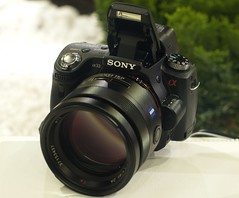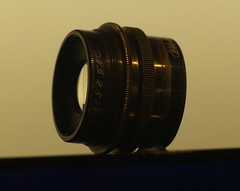The Planar is a double Gauss lens design with six elements developed by Zeiss. It was designed by Paul Rudolph who had already designed Zeiss' first anastigmats. The Planar is also anastigmatic, and named for its flat image plane. Being a Gauss type, the lens is symmetrical; each half comprises one converging element and a diverging cemented pair (the cemented groups are in the centre of the lens, closest to the iris diaphragm). The symmetrical design gives inherently low chromatic aberration; however, it suffers from coma.[1] The first version was an f/4.5 lens.
The strengths of the Planar's construction were further developed after the invention of lens coating because the original construction suffered flare. A variant with seven elements was made for 35mm cameras (Glatzel-variant). The Planar remains a Zeiss product,[2] and was the model for many other lens constructions. Most of the derived lenses are not completely symmetrical. The renowned Carl Zeiss f/0.7 50 mm was used by NASA for lunar photography and by Stanley Kubrick to film scenes with just candlelight. Yet even this design is recognizably a Planar (double Gauss) formula followed by a focal reducer (or "speed booster" in modern terms).
Many fast lenses with focal lengths between 35 and 85 mm are derived from the Planar, and even in 21st-century designs it remains viable.
Notes
Links




